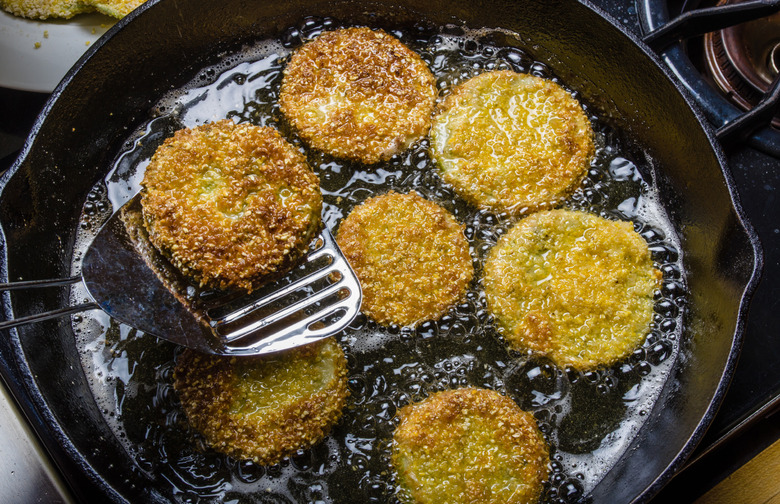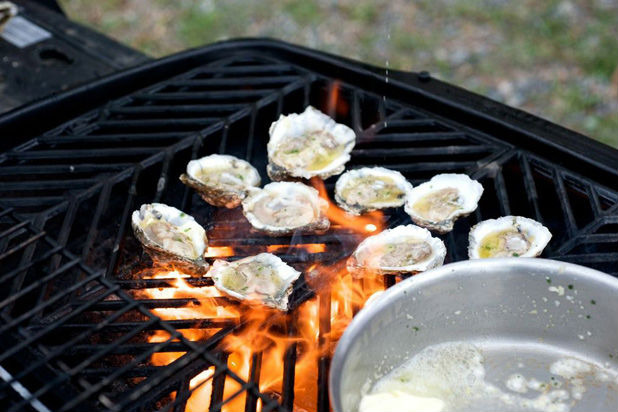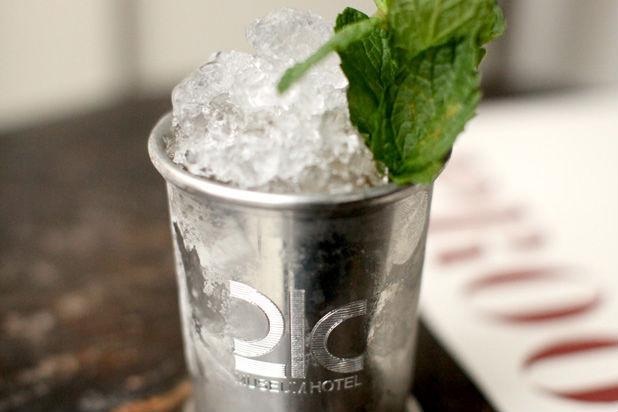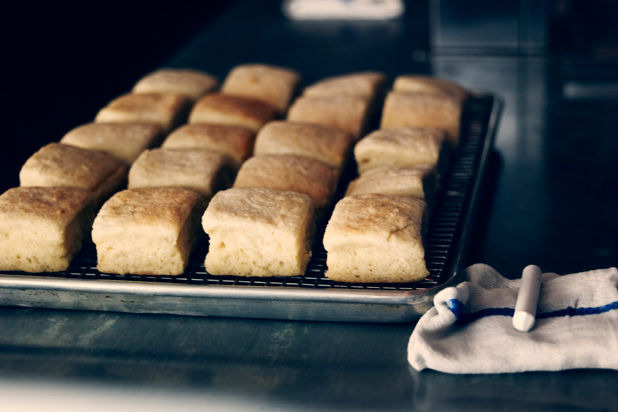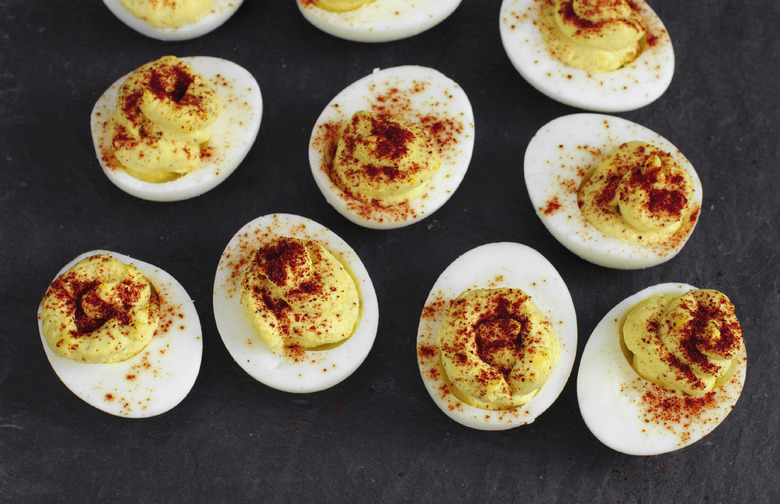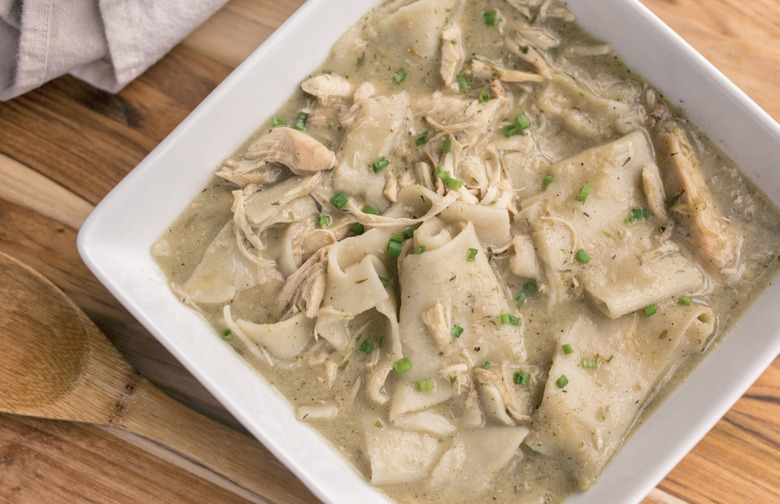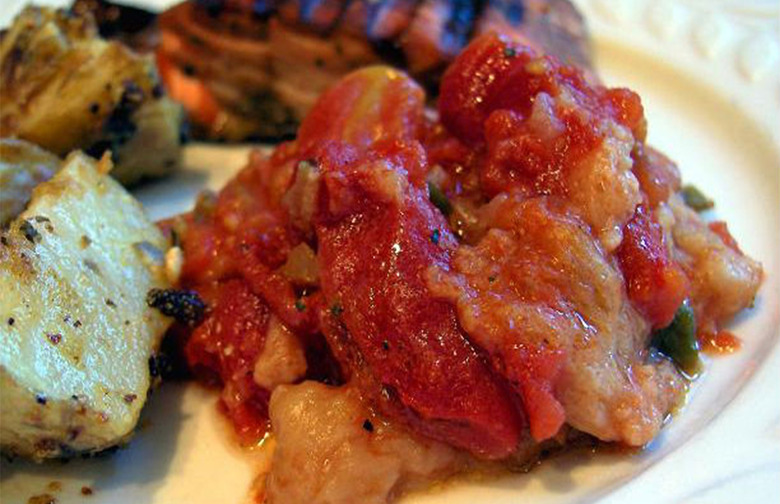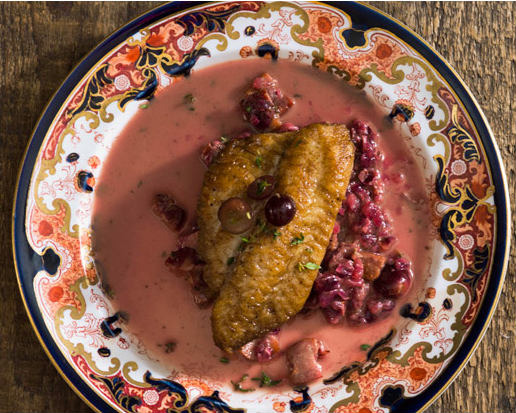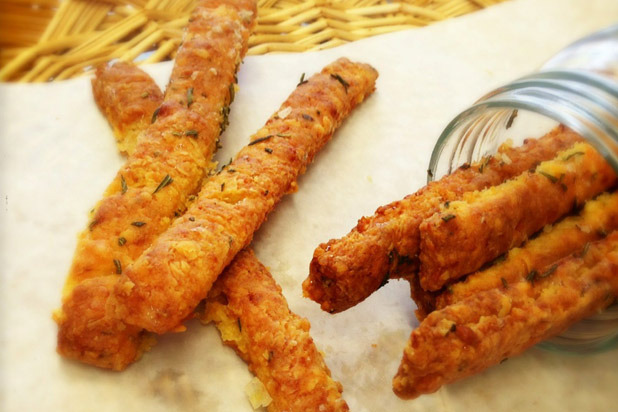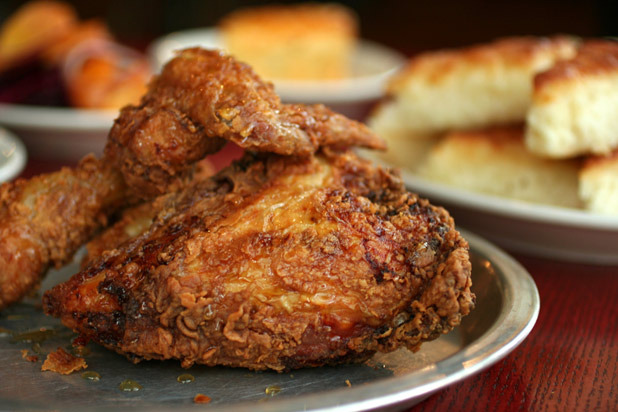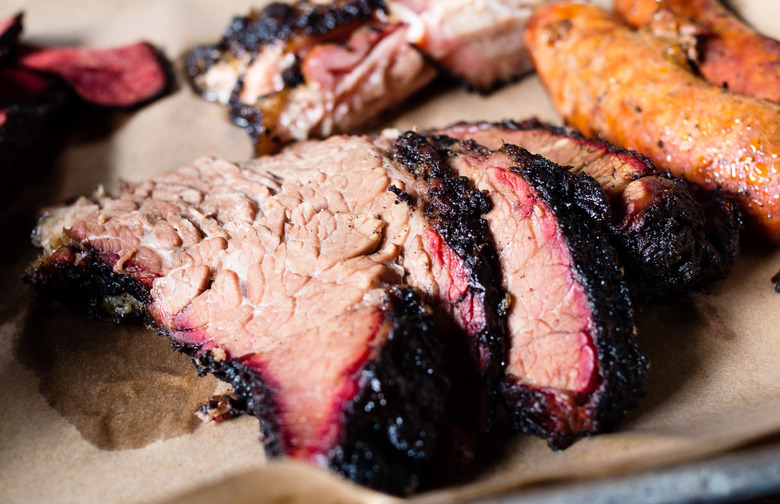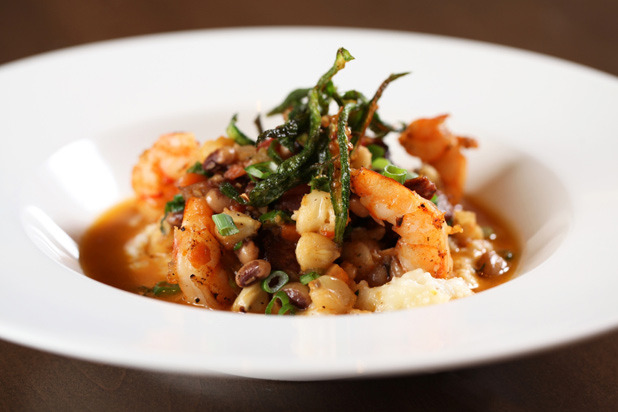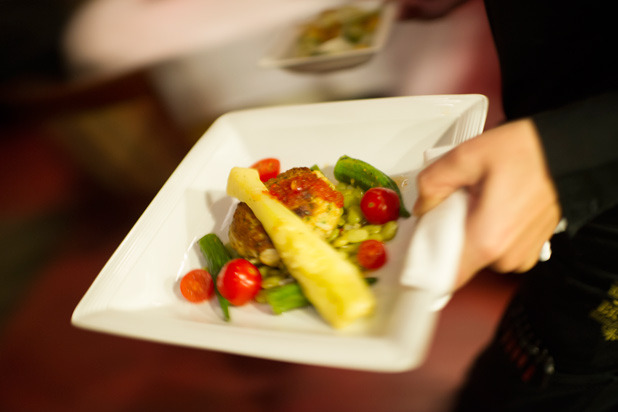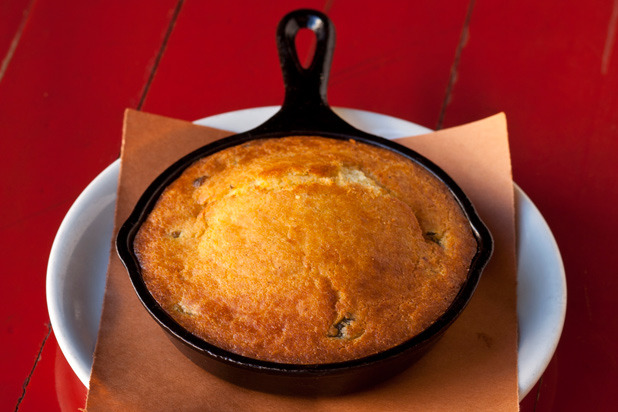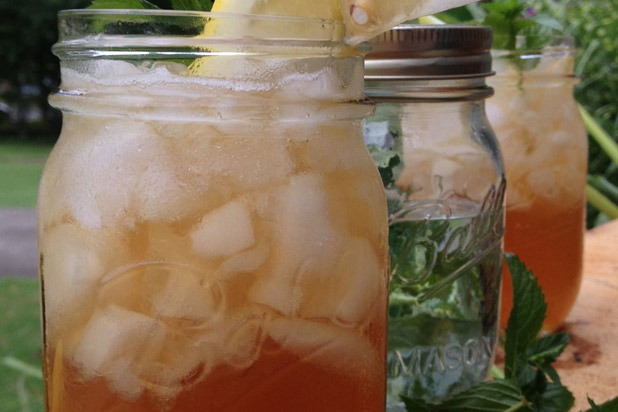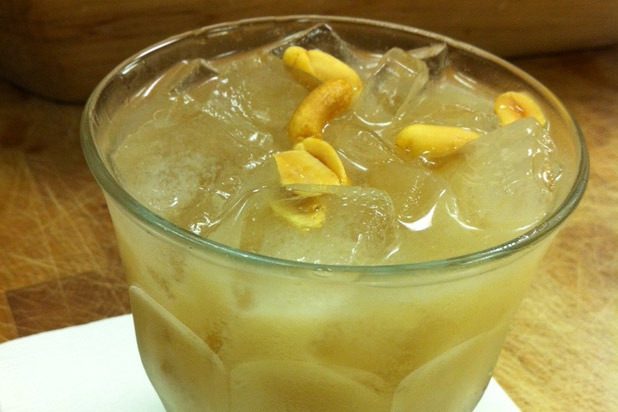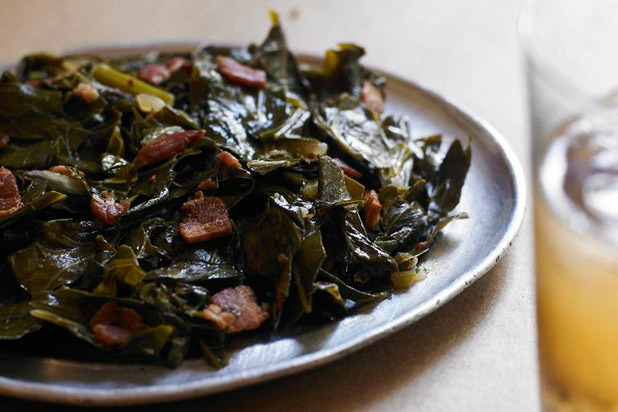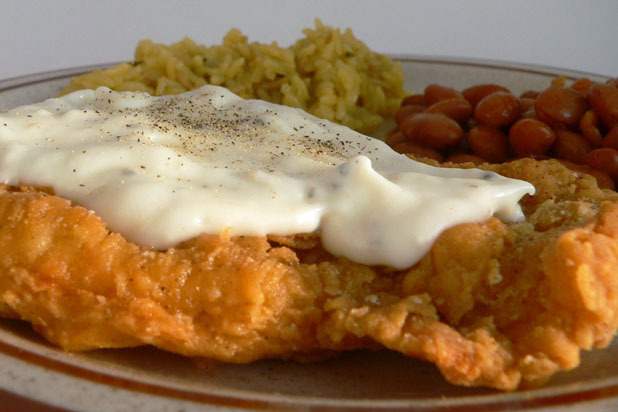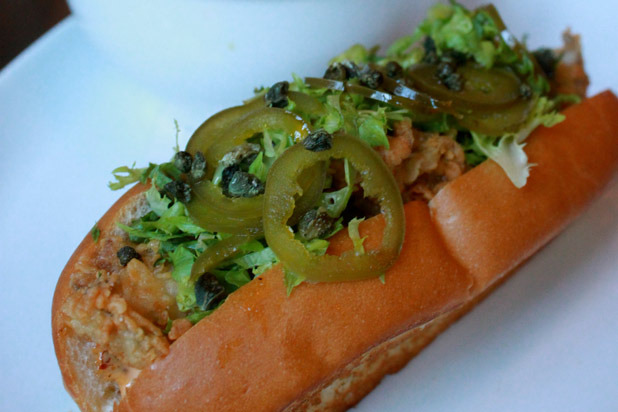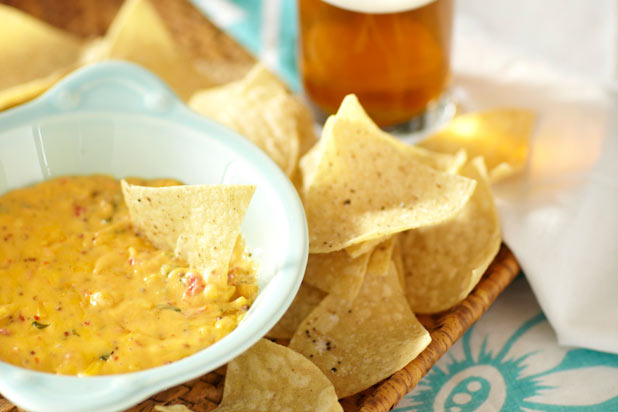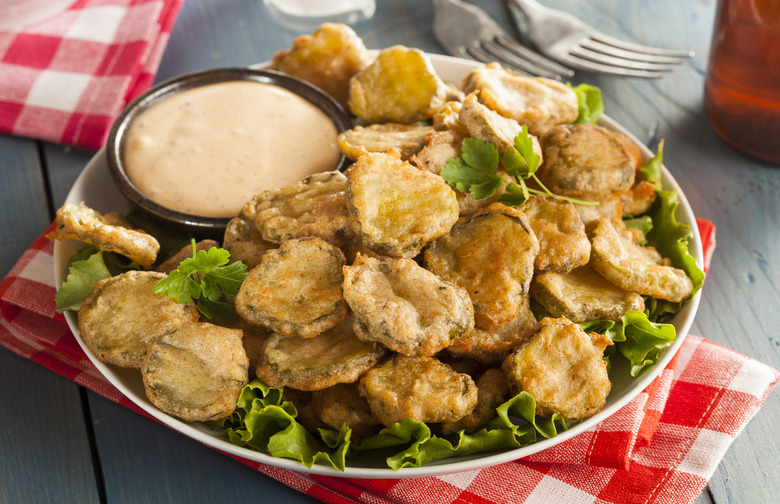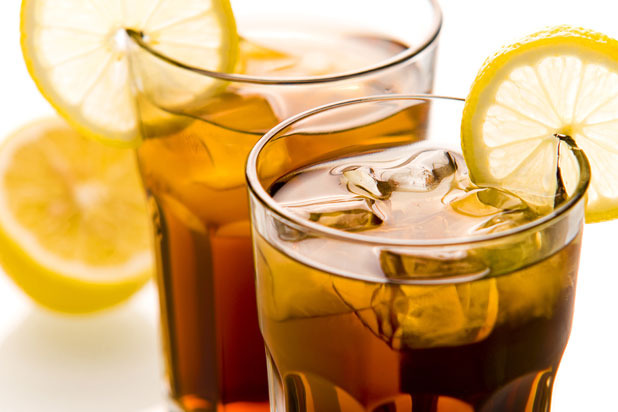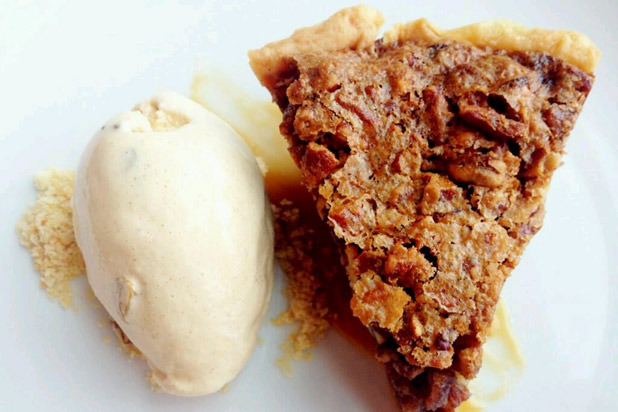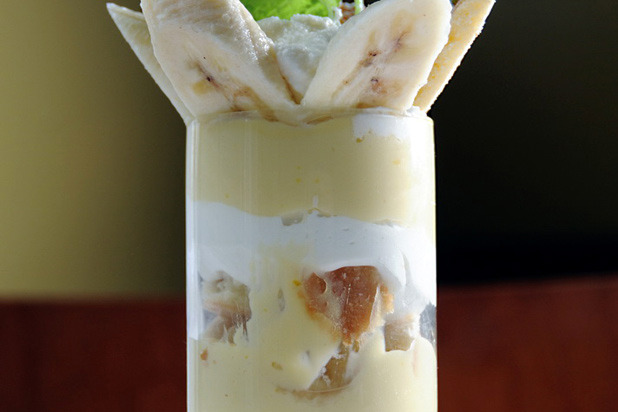24 Iconic Southern Dishes You Need To Know How To Cook (Slideshow)
We may receive a commission on purchases made from links.
While fried green tomatoes reportedly may have originated from Jewish immigrants entering the American Northeast and Midwest, they now have strong ties to the South. The dish that shares the same name as the 1991 movie starring Mary-Louise Parker and Mary Stuart Masterson, based on Fannie Flagg's 1987 novel, has become a staple in Southern kitchens and restaurants despite its roots, perhaps due in a large part to its savory, crunchy taste that pairs so well with other typical Southern dishes. Whatever the case, fried green tomatoes have now become a beloved and accepted Southern staple, and Hominy Grill, based out of a historic single house in Charleston, S.C., shows us how to fry up a really good batch of tomatoes.
Roasted Oysters (Rappahannock Oyster Co.)
While admittedly difficult to eat at times, oysters provide a salty, rich flavor and an abundance of iron, protein, and calcium. When English settlers arrived in the Chesapeake Bay area, the Native American inhabitants introduced them to the idea of eating oysters, and by the 1680s the colonists were harvesting oysters themselves, beginning a longstanding tradition within the region. Rappahannock Oyster Co., based in the Chesapeake Bay, continues that tradition of Southern oyster harvesting and eating and shares their advice for roasting your own oysters.
Mint Julep (Proof on Main)
Most commonly associated with ladies in big hats betting on horses, the mint julep is typically made with bourbon, sugar, water, and mint and served in a silver julep cup. The drink originated in the South and was introduced to Washington, D.C. society by that famous Kentucky senator Henry Clay, who was an ardent fan of the drink. It is typically connected to the Kentucky Derby and has been promoted by Churchill Downs since 1938, with the track going so far as to introduce a $1,000 luxury mint julep in 2006. The Louisville, Ky., based restaurant and bar Proof on Main boasts an impressive arsenal of excellent bourbon and shares their recipe for the perfect mint julep here.
Buttermilk Biscuits (Seersucker)
While the term "biscuit" originally referred to a cookie-like shortbread, after the Revolutionary War Americans started using the term as they do today to mean a small piece of bread with a crispy exterior and a soft interior. The softer winter wheat that grows in the South was the perfect ingredient to make the fluffy, quick bread used for biscuits and they quickly became staples in the South. Served as sides to entrées or with gravy, butter, or ham as a breakfast dish, biscuits are a Southern classic. Arkansas native Robert Newton shares the recipe for his fluffy buttermilk biscuits baked in his Brooklyn, NY-based modern Southern restaurant, Seersucker.
Deviled Eggs (Roost)
A staple at church gatherings and family picnics across the South, the deviled egg is a classic appetizer easily set out for entertaining. There are a variety of deviled egg recipes, stretching as far back as ancient Rome, where it was seasoned with broth and wine, and medieval Europe. Yet in the South, this dish has been widely embraced as a mixture of ingredients such as mayonnaise, mustard, pepper, and relish and has become so popular it has even spurned the creation of its very own serving plate, the deviled egg dish. Even if you don't have your own deviled egg serving dish, recreate the classic side this summer with a recipe from Roost of Greenville, S.C.
Chicken and Dumplings (Virginia's on King)
This comfort food is made by boiling chicken, using the resulting broth to cook the dumplings, and combining the two with salt and pepper. The term "dumpling" originated during the 17th century and referred to a chunk of boiled or steamed dough. It was originally added to dishes to make them more filling, hence its combination with the chicken and broth. It has become a staple dish in the South due to its warm, hearty consistency and the Charleston, S.C. restaurant Virginia's on King shares their recipe for Chicken and Dumplings here.
Tomato Pudding (Hominy Grill)
While tomatoes and pudding may sound like two things that don't really go together, this dish has been a classic Southern side since before the Civil War. With its combination of tomatoes, bread, sugar, salt, and the fact that it's served warm, it's easy to see why this dish is a hearty reminder of traditional home cooking. Hominy Grill of Charleston, S.C., shares their recipe for the long-standing Southern favorite — serve it with warm biscuits and the "tomato" and "pudding" combination will suddenly make sense.
Catfish (MilkWood)
Often found in the waters of the Southeastern United States, catfish became a crucial staple for impoverished Southerners, as it was relatively cheap and easy to find. It was often looked down upon by others, who saw it as a poor substitute for more valued fish, yet Southerners came to love it, serving it dusted with cornmeal and deep-fried alongside hush puppies and coleslaw. However, with the current rise of farm-raised catfish, it is now a popular choice and has become the basis for a wide array of flavorful new dishes that build and expand upon its Southern heritage. Chef Edward Lee of MilkWood in Louisville, Ky., shares his take on the traditional Southern dish, creating a unique recipe for pan-fried catfish in bacon vinaigrette.
Cheese Straws (Red Truck Bakery)
Although no one knows the cheese straw's exact origin, it is thought that cheese straws originated when a Southern cook mixed leftover biscuit dough with cheese, formed it into long strips, and then baked them alongside a pan of biscuits. Usually eaten as snacks, cheese straws are the potato chips of Southern cocktail hour — you can't eat just one, and once you've opened a tin, you have to resign yourself to pretty much eating the entire container. Brian Noyes of Red Truck Bakery in the Virginia hunt country was kind enough to share his recipe for his homemade cheese straws, which he makes in a renovated 1921 Esso filling station with just three bakers.
Fried Chicken (Beasley's Chicken + Honey)
Scottish immigrants coming to the Americas brought with them their tradition of deep-frying chicken in fat, in contrast to their English counter parts, who often boiled or baked their meats. With the introduction of the cast-iron skillet in the 1800s, chicken, lard, and flour began to be combined in the Southern kitchen and developed into what we today call fried chicken. Chef Ashley Christensen shows us how to fry some real, Carolina chicken and shares her celebrated fried chicken recipe from her Raleigh, N.C., restaurant Beasley's Chicken + Honey.
Barbecue (4th & Swift)
Some people think that the term "barbecue" is simply a verb or can apply to anything covered in BBQ sauce, but in the South it means a very specific thing: meat slow-cooked over a fire for an extended period of time to create a smoky, savory flavor. It is thought that the term barbecue originated from the Spanish word barbacoa, which the Spaniards used in reference to witnessing Caribbean natives' practice of slow-cooking meat. The cooking method became prevalent in the American South by the 19th century and, with pigs being common animals in the region, pork became one of the main meats used for barbecue. Chef Jay Swift of 4th & Swift in Atlanta shows us his twist on a classic recipe, substituting in beef short ribs for a revamped Southern dish.
Shrimp and Grits (Southern Art)
Originally a breakfast staple of South Carolina fishermen in the Lowcountry, shrimp and grits has become an iconic Southern dish. The warm, buttery grits blend perfectly with seasoned shrimp to create a meal that is simple yet delicious. Chef Art Smith, previously the personal chef to Oprah Winfrey and a favorite from Top Chef Masters, shared with us his shrimp and grits recipe from his Atlanta restaurant Southern Art. Smith serves his grits with Cheddar cheese, Andouille sausage, and garlic, creating a meal that is both savory and filling.
Crabcakes (Slightly North of Broad)
Crabcakes are a signature dish of the Chesapeake Bay area, where the blue crab thrives. This type of crab is considered one of the best for making crabcakes and was introduced to settlers in the Chesapeake by the Native Americans who originally lived there. Often breaded with seasonings and deep-fried, crabcakes are served on everything from sandwiches to salads. Slightly North of Broad in Charleston, S.C., sent us their recipe for a Lowcountry crabcake, complete with a crispy coating of panko breadcrumbs and seasoned with parsley and nutmeg.
Cornbread (Percy Street Barbecue)
When English colonists settled in what is now the Southeast United States, they were introduced to the Native American staple of corn and began to use it in their own recipes. In an attempt to replicate the grain-based bread from their native Europe, the colonists started to bake their own bread out of cornmeal and the cornbread dish was born. Typically cooked in a skillet, cornbread is a Southern side served hot in baskets on the dinner table or next to a plate of green beans and barbecue. Chef Erin O'Shea hails from Richmond, Va., and is one of the owners of Percy Street Barbecue in Philadelphia, lauded for its smoked meats. Here, she shares her Texas-inspired cornbread recipe with us.
Moonshine Cocktail (Loveless Cafe)
The term moonshine can refer to any type of alcohol that is secretly produced to avoid government taxes or bans on alcohol. After the Revolutionary War, the United States government was struggling for funds and so placed a tax on spirits and liquors, causing great displeasure amongst the new American citizens (and understandably so). Many farmers continued to turn their corn into whiskey and ignored the federal tax, as it took away revenue from their desperately needed incomes. Many of these moonshiners were located in Kentucky, the Carolinas, Virginia, and Tennessee and continued their practices throughout the temperance movement of the 20th century, using the nationwide Prohibition of the 1920s to their greatest advantage and delivering illegal liquor to speakeasies. Although the need for smuggling illegal liquor has passed, moonshine still remains a Southern favorite. The Loveless Café in Nashville, Tenn., shares the recipe for their take on the age-old liquor, The Beesting Moonshine Cocktail — it may not be covertly delivered, but its combination of honey, sweet tea, and moonshine more than makes up for that.
Tallulah Cocktail (Ollie Irene)
Coca-Cola is itself a product born and bred in the South — it was created in 1886 by John Pemberton, a pharmacist in Atlanta, and soon spread beyond pharmacies and, as we know, eventually grew to become a drink beloved by the whole world. Yet it still retains its Southern roots, and most people born and raised in the South can remember partaking in this age-old tradition as a kid: pouring a packet of peanuts down the throat of a bottle-necked Coke. It sounds strange, but the salty and sweet combination is the perfect, simple refreshment. Ollie Irene in Mountain Brook, Ala., puts a twist on this classic cocktail, slipping in some Jack Daniel's and peanut orgeat for an adult take on this childhood favorite.
Collard Greens (Table & Main)
One of the oldest members of the cabbage family, collards are related to kale and have been eaten for centuries, as accounts exist of ancient Greeks and Romans growing collards themselves. The Southern style of cooking collards arose when domestic workers on farms would boil them with leftover ham hock or salt pork to diffuse the bitter taste of the greens. Served alongside black-eyed peas, the dish has become a New Year's Day staple for those believing the superstition that the dish will bring them luck in the coming year. Chef Ted Lahey of Table & Main in Roswell, Ga., shared his recipe for collards, which uses bacon, red peppers, and vinegar to give the greens a Southern kick.
Fat Tommy's Chicken Fried Steak (Thomas O. Ryder)
The earliest mention of a recipe similar to chicken fried steak was in 1839 in the The Virginia Housewife by Ms. Mary Randolph, and some believe that it was the settlement of Germans in Hill Country, Texas, that brought this dish, which is alarmingly similar to their classic dish wiener schnitzel. No matter how it came to the South, we're happy it did. This recipe features Lawry's seasoning in both the buttermilk wash and the breading, for a savory, crispy steak that is fried to perfection.
Shrimp Po'Boy (Empire State South)
For those of you unfamiliar, a po' boy is a submarine sandwich made on French bread and typically stuffed with fried seafood such as shrimp, catfish, oyster, or crab. It reportedly originated in New Orleans when streetcar conductors and motormen began striking due to threats against their union and pay; Bennie and Clovis Martin, owners of Martin Brothers' Coffee Stand and Restaurant, were previous streetcar operators themselves and supporters of the union and vowed to serve a free meal to any streetcar operator on strike in New Orleans. They fed those "poor boys" huge sandwiches of French bread stuffed with meat to keep them satisfied while they were protesting, and the name stuck. The sandwich is now an integral part of the New Orleans identity and has spread throughout the South as well. The modern Southern restaurant Empire State South of Atlanta shares their take on the classic shrimp po'boy with us here.
Pimento Cheese (Tupelo Honey Cafe)
Sometimes referred to as "The Caviar of the South," this dish makes a common appearance in Southern households on top of everything from crackers and chips to celery and sandwiches. Made from a mixture of mayonnaise, pimento peppers, and Cheddar cheese, the spread became popular in the early 20th century when it was served on elegant sandwiches at elite tea parties. Originally seen as a delicacy due to the high price of cheese and imported pimento peppers, it was widely adapted by the mainstream South when James Lewis Kraft began making processed cheese in 1915 and Southern farmers began growing pimento peppers, lowering their cost. It soon became a lunch staple for Southern textile mill workers who didn't receive much time on food breaks and found that grabbing a pimento cheese sandwich was both a quick and delicious way to get a meal. The spread is now considered a traditional dish of the South, and Asheville, N.C.'s Tupelo Honey Café shares their revamped take on the pimento cheese recipe here, creating a cheesy dish served warm as a dip.
Fried Pickles (West Egg Cafe)
Bernell Austin reportedly first made fried pickles popular in 1963 at his Duchess Drive In in Atkins, Ark. They were originally sold in the small, circular form found on hamburgers for $0.15 for 15 pickles, yet Austin was not satisfied with the way they looked and eventually moved toward frying them sliced lengthwise. The combination of the salty pickle and the warm, crispy breading was immensely popular and the dish quickly spread throughout the South and is now a staple at state fairs or as an appetizer or side dish. West Egg Café in Atlanta shows us how to make your very own fried pickles at home.
Sweet Tea (Nicole Campoy-Leffler)
With South Carolina being the first state that tea was grown in the United States, it's no surprise that the South has claimed it as their signature drink, with sugar, of course. The first publication of sweet tea is believed to be in 1839 in a cookbookThe Kentucky Housewife, and it's become a fixture of Southern dining ever since.
Pecan Pie (High Cotton)
It is said that the pecan pie originated in New Orleans during the early 19th century after Native Americans introduced French settlers to the pecan nut. Often made with corn syrup and served with whipped cream or ice cream, it is a classic dessert that makes a regular appearance at the Southern dinner table — not just at Thanksgiving. Chef Joe Palma of High Cotton Maverick Bar & Grill in Charleston, S.C., sent us his recipe for their pecan pie made with brown sugar and a cup of melted butter — sounds good to us.
Banana Pudding (South City Kitchen)
Banana pudding was probably inspired by the trifle, a British dessert that layers cake, custard, fruit, and cream. While there is evidence of some bananas making their way to the Americas during Colonial times, most Americans did not encounter the fruit until they began to be largely imported from Latin America in the 1870s through New Orleans and Charleston. Subsequently, recipes for the banana pudding dessert began to be found in cookbooks around the beginning of the 20th century. When four-lane highways began showing up more often in the South during the 1960s, bananas were more frequently shipped to grocery stores within the area and the price of the fruit became lower, making banana pudding an easy staple on the Southern dinner table. Chef Chip Ulbrich of South City Kitchen in Atlanta shared his recipe for the dessert with us; his addition of banana liqueur to the dish takes this from a church bake sale classic to an amped-up, sinfully good treat.
